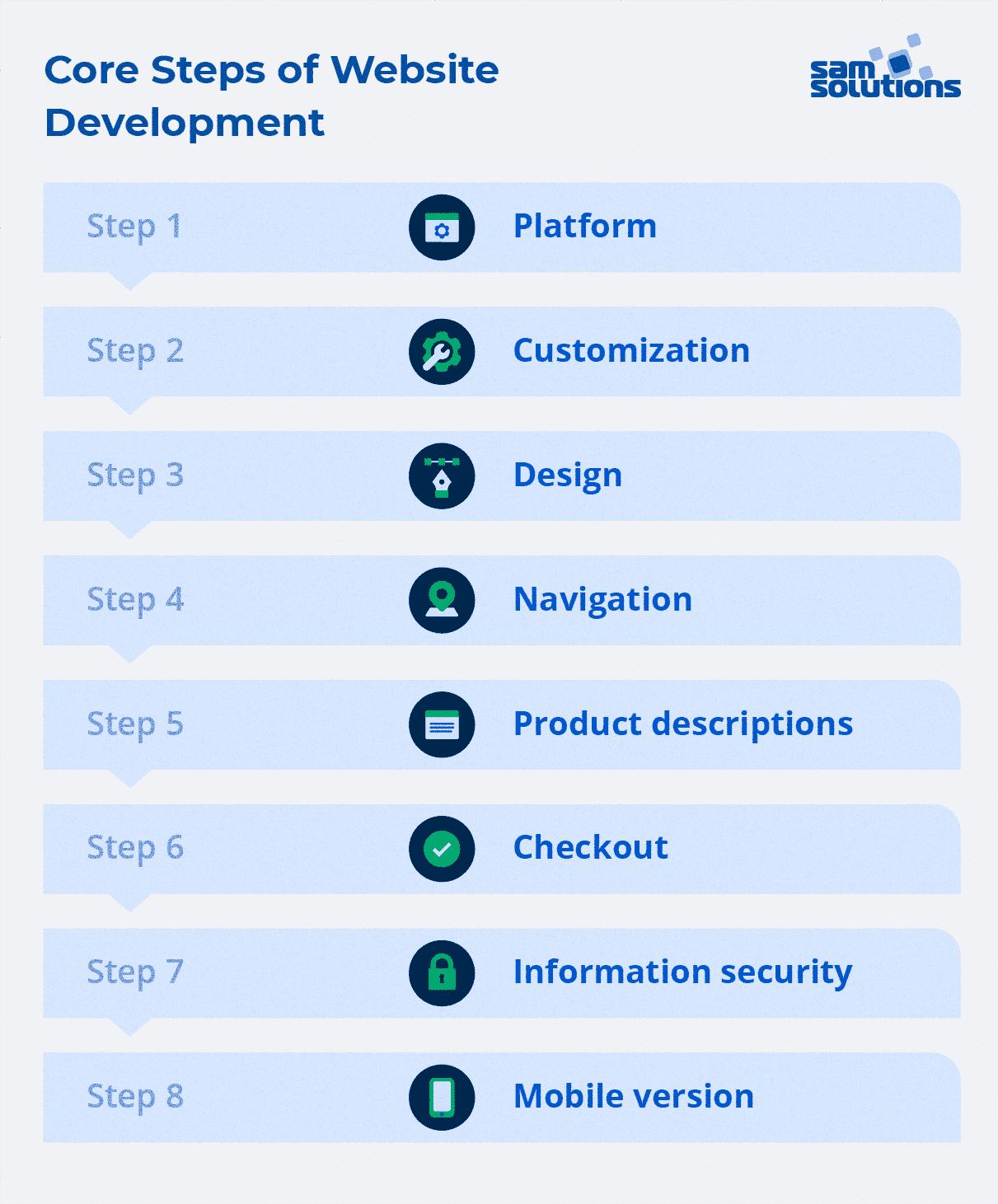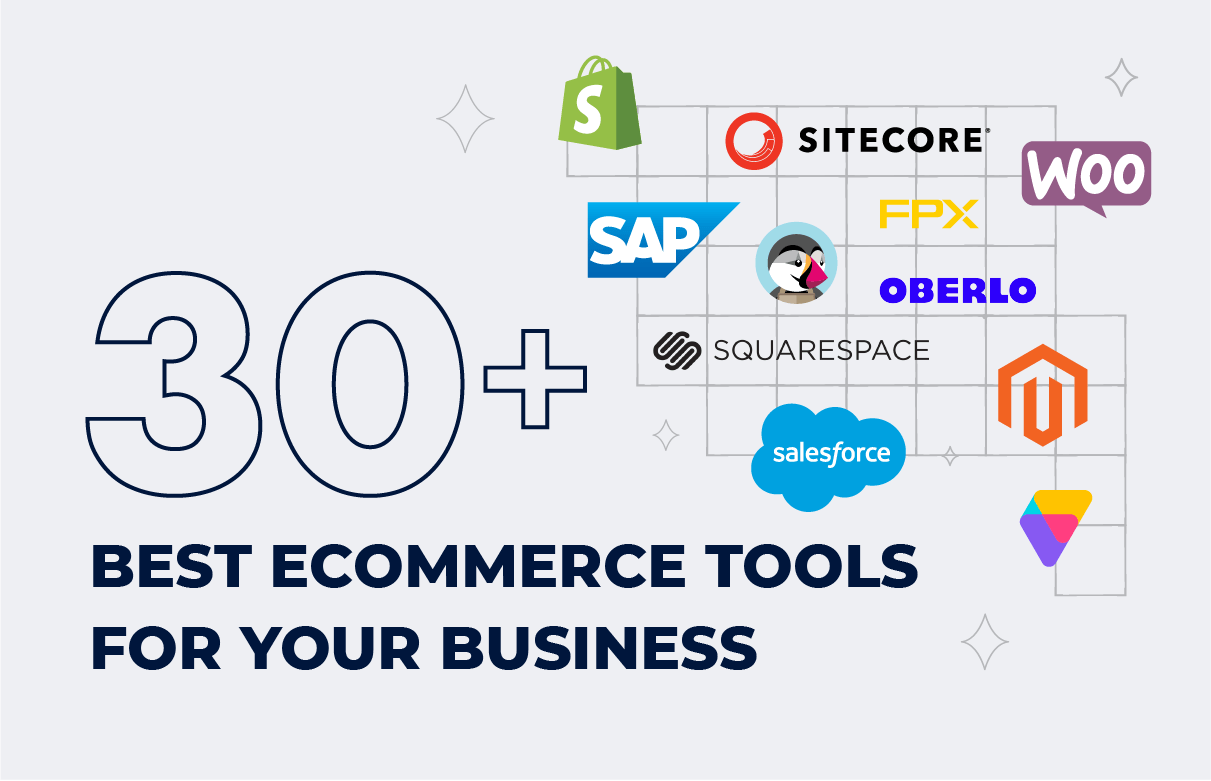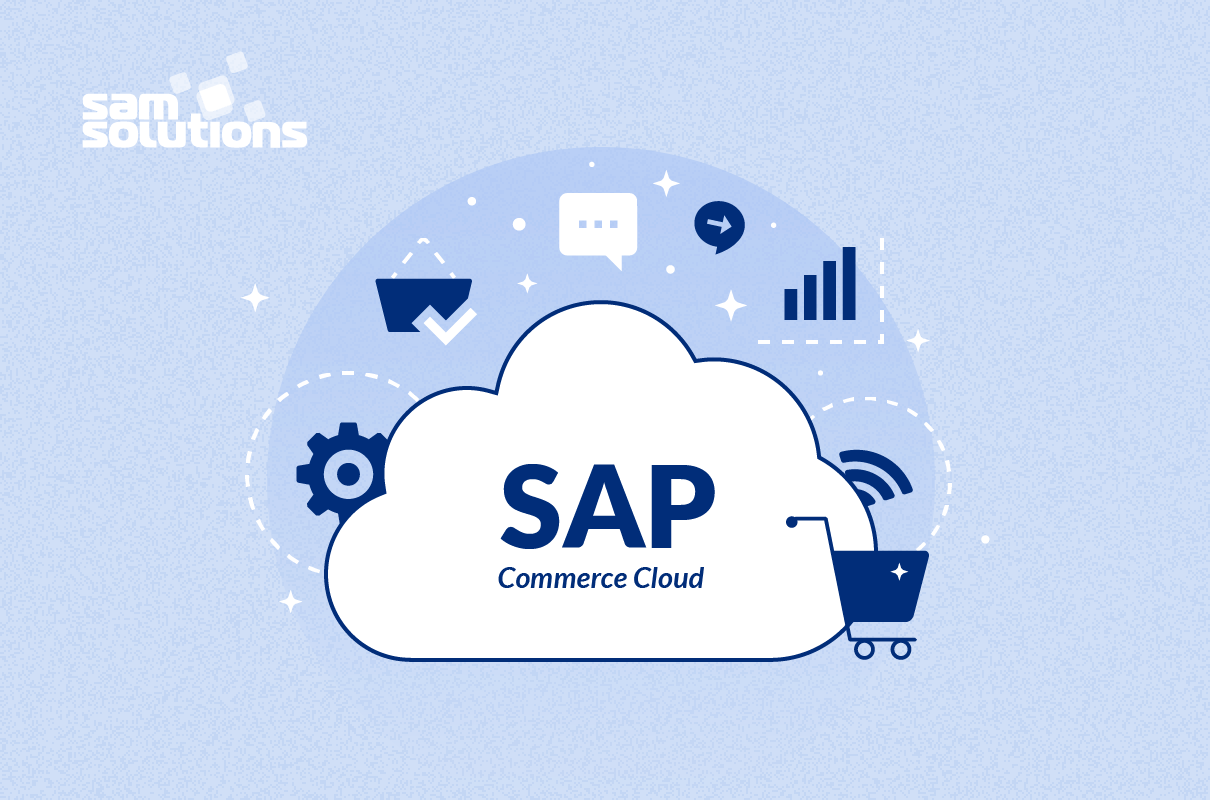Today, retail eCommerce sales worldwide account for $3.53 trillion, according to Statista, and we continue witnessing its fast growth. To succeed in the industry, merely having an eCommerce website is no longer enough. Instead, companies should make sure that their online presence is efficient and engaging, by developing well-thought-out websites that encourage conversions. Read on to learn how to build a successful eCommerce website.
A Step-By-Step Guide to Creating an Effective eCommerce Website
Creating an eCommerce website that will boost online sales is not magic, but rather something that’s available for every company. The only thing is, it requires abiding by certain rules and tips.
SaM Solutions offers a wide range of platform-based and from-scratch ecommerce development services that help you reach your digital sales objectives.
Before we start exploring the rules of creation of a productive eCommerce website, make sure you have, or are preparing to have, the following essentials:
- A recognizable, consistent brand. Create your own unique brand image that customers will easily recognize — logo, slogan and visual representation that sets you apart from the competition, which you will use on your site.
- A clear-cut marketing strategy. A stand-alone site that is not part of a comprehensive marketing plan is almost useless, so prepare a strategy that will allow you to make the most out of your online presence.
- An estimate of the number of orders you can handle. What you promise on your website should be perfectly aligned with your real possibilities and with customer needs. That is why you should estimate beforehand how many orders you can process and whether it’s what clients expect from you, and stick to it.
- Scalability and flexibility. A website should be easily extended or upscaled as your business or product range grows, without losing efficiency.
After you have made provisions for these essentials, you can start with the development of an eCommerce website that will become your online persona. Generally, website development should include the following steps:
- Choosing an efficient platform to host your site
- Customizing the website so that it will meet business needs and expectations
- Creating an attractive, user-friendly design
- Adding convenient navigation
- Providing informative product descriptions
- Developing an easy and intuitive checkout process
- Ensuring safe and secure handling of sensitive data: payment-related and personal user information
- Building a responsive mobile version
Now, let’s get into each of these steps in more detail.

The Choice of the Platform
The choice of a platform depends heavily on what companies expect to get from their online shopping solutions. For small businesses, no-frills open-source platforms may be sufficient, as they are available for free or have lower licensing costs, and their setup and configuration don’t require much development effort. Bigger companies need a more sophisticated eCommerce website structure and capabilities; with wider product ranges, they need highly flexible platforms that support endless customization.
Today, there is a wide range of eCommerce platforms, and every business can find a solution that meets its requirements. Let’s have a look at a short overview of the world’s top eCommerce platforms based on their Builtwith.com rating.
1. WooCommerce One Page Checkout

A free plugin for WordPress, WooCommerce allows businesses to add eCommerce functionalities to their WordPress websites. With WooCommerce, businesses can customize their sites by downloading or buying extensions or themes to enhance embedded functionality or user interface, and it doesn’t require coding. As it’s free and has extended configurability, WooCommerce is supremely popular among online merchants of all sizes, and particularly small-to-medium companies and startups.
The One Page Checkout platform enables the conversion of any product page into a page with a checkout. Such pages combine both product information and the checkout functionality, which streamlines the payment process and prevents buyers from abandoning their carts.
2. Wix eCommerce

Wix eCommerce is an all-in-one platform for the development of eCommerce websites. The platform allows companies to create websites and mobile apps via the online drag-and-drop website builder that provides a wide range of applications, tools, plugins, etc.
The platform provides both free-of-charge and subscription-based versions. While the free model is straightforward and has limited capabilities, the paid version enables extensive customization.
3. Shopify

A one-stop-shop platform, Shopify requires little to no development knowledge for maintenance, while allowing businesses to customize it as much as they require. The variety of license plans makes Shopify a good choice for businesses of all sizes — from tiny startups to large corporations.
A fully hosted platform, Shopify has a lot of useful features out of the box. It also supports easy customization, with the help of various modules and extensions.
Enterprise-Level eCommerce Platforms
The above-mentioned platforms are perfect for SMEs, while huge enterprises may require more powerful functionalities and capabilities. Some of the big market players are SAP Customer Experience, Oracle Commerce, IBM WebSphere Commerce and Magento Commerce.
Although these solutions are quite costly, large companies with multi-billion-dollar revenues recoup their investment completely, as these platforms add value to any large business by seamlessly supporting high-volume operations. With these enterprise eCommerce platforms, companies can create individually tailored websites that meet their specific needs.
Platform Customization
Acquiring a license or subscription is only the first step on the way to a full-fledged online shop. In most projects, out-of-the-box features are not enough and platforms must be properly customized according to business needs and specifics. This includes the platform’s setup and configuration, and the addition of necessary modules and extensions.
For example, say a company offers thousands of products, provides shipping and accepts various types of payment. In this case, an eCommerce website needs a lot of product pages to be created, payment systems to be connected, and other functionalities (such as blogging tools, shopping carts and so on) to be set up.
Some platforms don’t require specific expertise and are so easily manageable that a non-tech user can utilize them to develop an eCommerce website. At the same time, sophisticated solutions such as Magento or SAP Customer Experience cannot go without professional development services.
Today, thousands of extensions and modules are available for download or purchase. Companies that cannot find the right solution among off-the-shelf plugins should consider custom development.
Website Design
To stand out among similar-looking online shops, retailers need to gain and hold customers’ attention. That is why businesses make enormous effort to provide interactive and responsive design, which now includes attractive look-and-feel, good usability and high-quality graphics.
Another reason eCommerce website design is a great idea is that almost half the buyers link it directly with the merchant’s credibility, according to research by Bluecorona.com.
Some ready-made themes and templates can be downloaded or purchased to improve a website’s interface and functionality. While these are comparatively cheap solutions, they are not the right choice for businesses seeking to distinguish themselves. Those companies turn to custom themes or even to custom-made website design.
There are a few elements that we recommend for a good eCommerce website:
- Place your bestsellers on the homepage as it saves your buyers time and anticipates their needs.
- Unite similar products into collections and add category filters to streamline searching and decision-making.
- Use product recommendations based on the available information about the buyer to boost sales.
- Provide detailed shipping information to improve customer experience.
- Add contact information and the feedback option to build trust.
- Provide a product ratings and reviews option and enable wishlists to improve buyer decision-making.
- Use high-quality product images and the zoom function for better representation.
- Make sure there’s enough white space for a more attractive page appearance.
We always recommend using a simple and clean design, as it doesn’t distract buyers and makes your site faster.
An important aspect of user-friendly UX/UI is intuitive navigation across your eCommerce website. This means that users should intuitively know where they can find a site section, instead of clicking randomly and failing to find what they need.
There are a few rules to help you create a sound website navigation system:
- Make sure website structure is logical.
- The main navigation menu is at the top and highly visible.
- The most important pages are at the top of the website hierarchy.
- Product categories are organized logically and in meaningful groups.
- The search bar is highly visible.
- Every page offers a straightforward way back to the home page.
Another important aspect, especially when it comes to product-laden eCommerce websites, is the robust search functionality. An efficient search function provides buyers directly with what they are looking for, without having to scan through pages of products. This helps buyers save their time and improves the customer experience. ‘Related searches’ and autocomplete functionality will make things even better.
Implementing these aspects will lead to a lower website abandonment rate, higher customer satisfaction and better sales. To be sure that everything is well considered and meets website visitors’ expectations, rely on A/B and user testing.
Exhaustive and Informative Product Descriptions
Providing personal consultations to customers is a very efficient way to approach them and influence decision-making, but this can’t be done in online commerce. What you can do, however, is to equip your online shop with detailed, informative product descriptions that will do the job of sales personnel and provide buyers with all they need to know. In order to do this, product information should be exhaustive, leaving no room for uncertainty and ensuing questions.
A good product description contains the following information:
- Rich overviews of features and capabilities
- High-quality images and videos that provide a 360-degree view of the product
- The manufacturer
- Shipping information
- Warranty details
- Prices and discounts
- Product availability
- Buyer reviews
The main aspect that distinguishes a brick-and-mortar store from an online shop is the possibility to see and touch a product, which is very important for decision-making. That is why we recommend paying close attention to product images and videos — make them realistic, detailed, easy to zoom and of high quality. Also, product demonstration in the context of their use will only add value to your descriptions.
When creating textual product information, use bullet lists instead of paragraphs as they are easier to follow and digest.
A Simple and Intuitive Checkout
In an area with very tight competition, make sure your potential buyers won’t abandon their carts due to an overly sophisticated checkout process. This means that your online store should enable easy adding of items to the shopping cart and streamlined checking out.
Make sure that forms are as simple as possible to fill in, and that you have an auto-save feature so that customers can quickly make purchases in the future. Guest checkout will also be extremely useful as it allows buyers to make purchases quickly and without registration. The ‘persistent’ shopping cart, which allows customers to come back later and find the cart contents unchanged, is also very handy.
Another aspect that significantly simplifies online checkout for customers is transparent information about everything that is connected to the products in their shopping cart and the checkout. So, information such as the amount or number of products they have added, the product name and price, the cart summary, delivery time and other important details should be transparent and visible without customers having to leave the cart to find it.
Other important additions to the design of the checkout process include:
- an eye-catching checkout button
- easy cart content editing
- different payment options
- no unexpected costs at checkout
- high loading speed
- the support department available at call
- an eye-catching promo-code and coupon button
- a simple and unfussy shopping cart design.
Security of Sensitive Data
Today, payment security is extremely important as the amount of user payment data on the Internet is skyrocketing, causing enormous cybercrime issues. That is why the provision of secure payments must become the number one concern for eCommerce companies.
Make sure that payment-related customer information is kept safe and secure 24/7. How is this done? By implementing:
- encryption
- PCI compliance
- authorization requests
- 3D security
You could also install an information security system, but this is a high-cost solution.
Along with payment-related information, personal user information is also a frequent target of cybercriminals. Secure Sockets Layer (SSL) technology helps prevent threats and exploits, and we recommend protecting your websites using SSL certificates.
These certificates encrypt sensitive information, and in so doing, they prevent intruders from reading and using it maliciously. You can use the following types of SSL certificates:
- Private SSL certificate, which is used when a company uses its domain name as the website URL. Involves considerable cost.
- Shared SSL certificate, which is used when a company uses the domain name of the hosting company as the URL. A cost-efficient option.
- Self-signed certificate, which is similar to the protection that private SSL provides, but not trustworthy as it’s signed by the website owners and not by authorized companies. May be useful during the development stage, until the website is launched.
Mobile-Friendliness
With an increasing number of buyers using their mobile devices, mobile responsiveness has become the must-have feature of any online store. That is why businesses should make sure that their websites are easily accessed via mobile phones, that they don’t lose their capabilities, scale accordingly to the screen size and look attractive.
To provide a seamless mobile user experience, use responsive design. This will ensure that your mobile website is user-friendly and that customers can access and fully use the same features and capabilities as those on the web version, such as:
- the shopping cart
- easy navigation
- streamlined design
- buttons large enough for accurate tapping
- high-quality but light-weight images.
With SaM Solutions’ ecommerce developers, you build a digital retail ecosystem that becomes your business’ key sales channel.
Do Your Best to Provide a Seamless Shopping Experience
Since eCommerce has become an integral part of today’s business operations, companies need to make sure that they use their online stores to the fullest. To benefit from an eCommerce website instead of losing money on it, we recommend following the steps that we listed above. It will allow you to create an online store that delivers a positive user experience, converts visitors into customers and brings profits.
To learn more about eCommerce website development, contact our team. With more than 10 years of hands-on experience, they will create a solution that will help you achieve your business goals.



















 The Latest 15 Information Technology Trends in 2024
The Latest 15 Information Technology Trends in 2024 Top 10 Embedded Software Development Tools
Top 10 Embedded Software Development Tools IaaS vs. PaaS vs. SaaS: What’s the Difference?
IaaS vs. PaaS vs. SaaS: What’s the Difference? 10 Examples of Predictive Analytics
10 Examples of Predictive Analytics







![What Is Ecommerce Customer Service? [Including 8 Best Practices]](https://www.sam-solutions.com/blog/wp-content/uploads/Customer-Service-in-eCommerce.png)




 Back-End Development with Java
Back-End Development with Java SAP Commerce Cloud (ex.Hybris) and S/4HANA Integration
SAP Commerce Cloud (ex.Hybris) and S/4HANA Integration Java Microservices Architecture: A Comprehensive Guide
Java Microservices Architecture: A Comprehensive Guide Azure Java Development: A Comprehensive Guide
Azure Java Development: A Comprehensive Guide SAP Commerce Cloud Accelerators (ex. Hybris)
SAP Commerce Cloud Accelerators (ex. Hybris)
WooCommerce, Shopify, and Wix are the best industry-leading platform for making an E-commerce website, and with the given steps, it is easier to implement them on these platforms where a website is created.
Such good information. WordPress is the best cms platform to build any type of Website.
Very good information, we recommend to get ideas of website design,
An e-commerce platform is a comprehensive software that allows companies to manage all operations related to online sales of products or services. E-commerce platforms create a centralized, digital hub for product and customer data, allowing e-commerce businesses to manage product information, personalize store content and layout, and process online transactions and payments.
You have written quite an impressive and well-detailed article for the e-commerce.
It has changed our lifestyle to such an extent that customers need not to visit the shopping malls for shopping. Now most of the people just want to visit the website and shop right from their home while sitting on their comfortable couches and enjoying at home.
Thanks for your Efforts.
I’m still a little cautious about buying on the Internet, as you can never be sure if these websites have any security measures.
The inception of the eCommerce industry not only brought about a drastic change in the lifestyle and shopping habits of people. But it also opened new opportunities for retail businesses.
This article is really informative an eCommerce website is hard to develop rather than any other site your website must be user-friendly and attractive. You also follow these steps as shown in the article.
Upvote to mobile friendliness. Pretty much everyone now shops on their phone, and it’s just silly to overlook an opportunity like this.
I think mobile responsiveness should be the first priority for any serious ecommerce business. I shop on the go, and I hate sites I can’t navigate using my smartphone. They’re not worth the effort.
I couldn’t agree more! An ecommerce website that hasn’t been properly thought through can make a real mess and destroy all marketing and promotion efforts, to say nothing about the loss of profit.
Thank you so much for this essential article!
As far as I understand that the price of making an e-commerce website depends on the customer’s business financial capacities, business plan and technologies to be used, the scope of features and the level of customization to be implemented as well.
It’s really important to know about previous developers work. And not only when you are going to develop a Magento website.